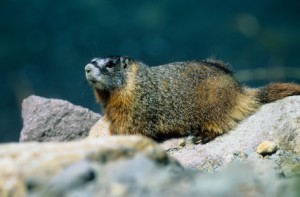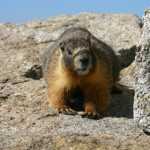Family, Description and Size:
The Yellow-Bellied Marmot, also known as Rock Chuck, is a member of the Marmot family and a type of ground squirrel. The Latin name of the family is Sciuridae to which chipmunks and squirrels also belong. It has a sturdy and fat body shaped like a pear, and thanks to its shape it can easily be told apart from its slender, tree-dwelling cousins. Its underside sports the yellow fur from which it has gotten its name. It has a rather short and fluffy tail and a head that reminds a bit of a beaver with four long teeth and small ears.
On average, a Yellow-Bellied Marmot will weigh 3.5 to 11 lbs, but it can be fatter during hibernation. Its body length ranges from 18.5 to 24 inches.
Range and Habits:
The Yellow-Bellied Marmot prefers dry and open-spaced habitats in the western United States and western parts of Canada, including the Rocky Mountains and the Sierra Nevada. It likes meadows, talus fields and even open spaces close to forests both deciduous and coniferous. Yellow-Bellied Marmots build their burrows beneath rocks so their predators cannot see and catch them as easily.
Yellow-Bellied Marmots are diurnal, which means they are most active during the day. They are omnivores, eating grass, flowers, leaves, fruit, insects and eggs whenever they can find them.
The animals can only be seen from April to August, because they spend the remainder of the year in hibernation, deep within their burrows. To survive such a lengthy period of hibernation the marmot must binge-eat during the four months of its active life. It is considered quite remarkable that the Yellow-Bellied Marmot manages to do so on such a low calorie diet.
General Information:
Yellow-Bellied Marmots reproduce when they reach the age of 2 years. They live in large communities called colonies, which can be up to 20 head strong. The male marmot will dig his own burrow as soon as he wakes
from hibernation. By summer he will have found up to four females to reproduce and live with him in his burrow. The male will have 3 to 5 young with each female of his “harem”. Their reproductive style is called harem-polygynous, meaning that one male will fight for and protect multiple females at the same time, with whom he alone will reproduce.
Predators, Mortality and Lifespan:
The main predators of the Yellow-Bellied Marmot are wolves, foxes, coyotes, domesticated dogs and humans. They will often be hunted when their colonies expand near farmlands, because the damage they do to the crops can be quite severe. The open space and plentitude of food found in farmlands are very alluring to the Yellow-Bellied Marmot and it will often colonize such spaces.
Marmots live on average up to fifteen years, yet many will die younger because of famine, disease and predators. The Yellow-Bellied Marmot enjoys a very healthy population despite all that and is on the least concern list of endangered animals.





[…] Rock Chuck Bullet Swage as they were specifically designed for making jacketed bullets to shoot the Rock Chucks in the Western United States, providing the acronym RCBS that the company would become known by in […]